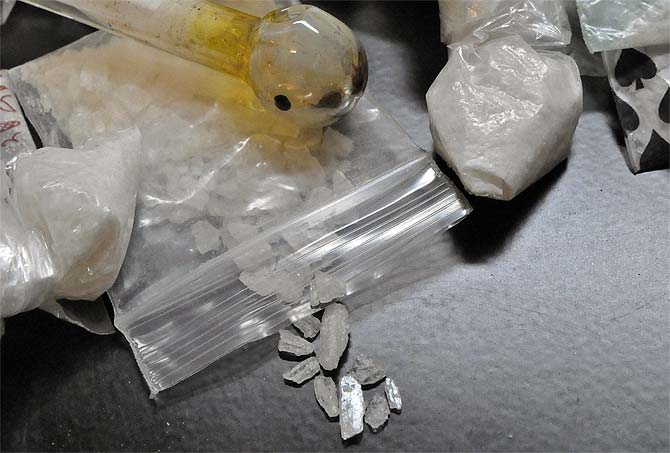Meth use down among Navajo County teens

(Times photo - Donovan Quintero)
Confiscated methamphetamine and the paraphernalia used to smoke it. Navajo Police say that though the use of the drug has decreased, other types of drugs may take its place.
By Jan-Mikael Patterson
Navajo Times
WINDOW ROCK, Nov. 13, 2008
T he war against methamphetamine continues for people on and around the Navajo Reservation, despite some encouraging news from the Arizona Criminal Justice Commission.
According to the 2008 Arizona Youth Survey, recently released by the commission, meth use statewide has declined over the past two years and less than 1 percent of Navajo County teens surveyed had used meth within the previous 30 days. The survey was conducted last spring.
Survey participants included 1,706 Navajo County teens, of which 39 percent was Native American. No high schools in Apache or Coconino counties were listed in the survey.
The survey covered 320 schools in 15 counties, with 54,734 students surveyed, including 4,812 Native Americans, or 7.4 percent. Statewide, 2.2 percent of those surveyed acknowledged using meth at least once, and 1.6 percent had used it within the previous 30 days.
In 2006, 14.2 percent of students surveyed statewide admitted to trying meth at least once, including about 10 percent of those in Navajo County. And for use within the previous 30 days, the figure was 4.1 percent statewide, and 3.5 percent in Navajo County.
The survey did not say which high schools in Navajo County took part in the survey.
"I know they surveyed some of the schools on the reservation but they didn't say which schools," said Debe Campbell, coordinator for the Navajo County Coalition Against Drug Abuse based in Pinetop, Ariz. "In years past they would only survey one or more schools but they won't tell you which schools."
According to Campbell, Navajo County youth still rank at double the state average rate for meth use at five percent to the 2.2 percent average throughout Arizona.
Meth is an illegal manmade narcotic in which the key ingredient - ephedrine - is cooked with household chemicals that produce a crystallized substance. It can be smoked, swallowed, snorted or injected.
Once cheap and readily available, meth has been made less attractive by tougher laws, increased enforcement, and public education campaigns aimed at showing the key market, young people, how meth destroys their good looks.
Laws have been changed to restrict access to ephedrine. Purchases of ephedrine-based over-the-counter meds are being monitored behind the counter as pharmacies. Customers are allowed to purchase limited amounts only and must provide identification, which is logged into a record kept by the pharmacy.
Meth has been explicitly outlawed on the Navajo Reservation, enabling Navajo Nation law enforcement to take a lead role in efforts to arrest traffickers. Previously, it was up to the FBI, with the assistance of tribal police, to tackle the problem.
The biggest meth case in Navajo County involved Effie "Grandma Meth" Nezzie of Dilkon, Ariz., her daughter and granddaughter, who were arrested for possession with the intent to distribute.
The Navajo Nation followed that with "Operation Broken Ice," a reservation-wide sting that netted 38 suspected dealers. Similar big crackdowns have taken place in other parts of the state.
"The bottom line is that meth is dying down, even through the media," said Samson Cowboy, director of the tribe's Division of Public Safety. But he cautioned against relaxing vigilance. "It's still an issue and it could flare up again."
The tribe has not conducted any surveys regarding meth activity, but Cowboy said his statements are based on a recent discussion with Navajo Police Sgt. Wallace Billie, the architect of Operation Broken Ice and other anti-meth efforts by police. The FBI's Nick Manns and U.S. attorney's office in Flagstaff are also part of the creation of operations.
Cowboy said meth was an issue where Navajo people were determined to fight it and like other social issues on the reservation, success comes in phases.
But the success of Operation Broken Ice led to another initiative, this one aimed at bootleggers. In the most recent reservation-wide crime crackdown, called "Operation Firewater," 27 people were arrested on bootlegging charges this summer.
The laws limiting public access to ephredine-related over-the-counter drugs has helped with the dramatic decrease in activities as well as the Navajo laws being modified.
"For Operation Broken Ice, we had a lot of information that came from Phoenix, Tucson and Albuquerque," Billie said, which helped with the crackdown. Of all arrested, one individual is still in custody.
There is also the decrease in meth labs as well, Billie noted.
"It's not gone," he added. "We're starting to see it come back again. We're going to try and hit the targets before it gets bad."
With the investigations continuing Billie could not elaborate any further. However, the bootlegging initiative is still ongoing and there have been a total of 31 arrested.
The idea for law enforcement, Billie said, is to go from reactive, where police respond after an incident, to pro-active, to prevent any incidents at all.
Unfortunately, with the decline in meth, another source for drugs is now within the home.
"Prescription drugs are beginning to rise," Billie noted, recalling an incident where students at Tse Yi Ghai school were passing out as a result of consuming valium.
"A lot of parents and grandparents need to be educated," Billie said. "They're going to have to lock up their medication now."

